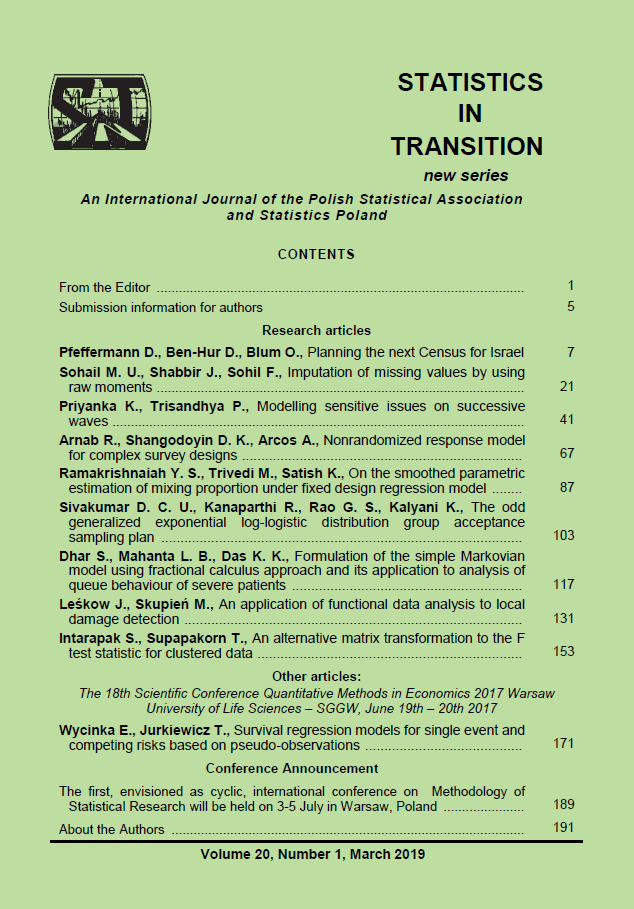ARTICLE
ABSTRACT
Vibration signals sampled with a high frequency constitute a basic source of information about machine behaviour. Few minutes of signal observations easily translate into several millions of data points to be processed with the purpose of the damage detection. Big dimensionality of data sets creates serious difficulties with detection of frequencies specific for a particular local damage. In view of that, traditional spectral analysis tools like spectrograms should be improved to efficiently identify the frequency bands where the impulsivity is most marked (the so-called informative frequency bands or IFB). We propose the functional approach known in modern time series analysis to overcome these difficulties. We will process data sets as collections of random functions to apply techniques of the functional data analysis. As a result, we will be able to represent massive data sets through few real-valued functions and corresponding parameters, which are the eigenfunctions and eigenvalues of the covariance operator describing the signal. We will also propose a new technique based on the bootstrap resampling to choose the optimal dimension in representing big data sets that we process. Using real data generated by a gearbox and a wheel bearings we will show how these techniques work in practice.
KEYWORDS
damage detection, functional data, functional principal components, informative frequency band
REFERENCES
BOSQ, D., (2000). Linear Processes in Function Spaces, Springer Verlag.
CHU, F., FENG, Z., LIANG, M., (2013). Recent advances in time-frequency analysis methods for machinery fault diagnosis: a review with application examples, Mechanical Systems and Signal Processing, Vol. 38, No. 1, pp. 165–205.
CIOCH, W., KNAPIK, O., LES´ KOW, J., (2013). Finding a frequency signature for a cyclostationary signal with applications to wheel bearing diagnostics, Mechanical Systems and Signal Processing, Vol. 38, pp. 55–64.
GRYLLIAS, K., ANDRE, H., LECLERE, Q., ANTONI, J., (2017). Condition monitoring of rotating machinery under varying operating conditions based on Cyclo- Non-Stationary Indicators and a multi-order probabilistic approach for instantaneous angular speed tracking, IFAC papers online, Vol. 50-1, pp. 4708–4712.
GUO, X, CHEN, L., SHEN, CH., (2016). Hierarchical adaptive deep convolution neural network and its application to bearing fault diagnosis, Measurement, Vol. 93, pp. 490–502.
HORVA´ TH, L., KOKOSZKA, P., (2012). Inference for Functional Data with Applications, Springer-Verlag, New York etc.
JIA, F., LEI, Y., LIN, J., ZHOU, X., LU, N., (2016). Deep neural networks: A promising tool for fault characteristic mining and intelligent diagnosis of rotating machinery with massive data, Mechanical Systems and Signal Processing, Vol. 72-73, pp. 303–315.
KHADERSAB, A., SHIVAKUMAR, DR. S., (2018). Vibration Analysis Techniques for Rotating Machinery and its effect on Bearing Faults, Procedia Manufacturing, Vol. 20, pp. 247–252.
KRUCZEK, P., WODECKI, J., WYŁOMAN´ SKA, A., (2017). Novel method of informative frequency band selection for vibration signal using nonnegative matrix factorization of short-time fourier transform, IEEE 11th International Symposium on Diagnostics for Electrical Machines, Power Electronics and Drives (SDEMPED).
LIU, R., YANG, B., ZIO, E., CHEN, X., (2018). Artificial intelligence for fault diagnosis of rotating machinery: A review, Mechanical Systems and Signal Processing, Vol. 108, pp. 33–47.
MAS, A., (2002). Weak convergence for the covariance operators of a Hilbertian linear process, Stochastic Processes and their Applications, 99, pp. 117–135.
OBUCHOWSKI, J. WYŁOMAN´ SKA, A., ZIMROZ, R., (2014). Selection of informative frequency band in local damage detection in rotating machinery, Mechanical Systems and Signal Processing, 48, pp. 138–152.
RANDALL, B., ANTONI, J., (2011). Rolling element bearing diagnostics - A tutorial, Mechanical Systems and Signal Processing, Vol. 25, pp. 485–520.
RAMSAY, J. O., SILVERMAN, B. W., (2002). Applied functional data analysis, Springer-Verlag.
RAMSAY, J. O., SILVERMAN, B. W., (2005). Functional data analysis, Springer- Verlag.
SPIRIDONAKOS, M. D., FASSOIS, S. D., (2014). Non-stationary random vibration modelling and analysis via functional time-dependent ARMA (FS-TARMA) models - A critical survey, Mechanical Systems and Signal Processing, Vol. 47, pp. 175–224.
STASZEWSKI, W. J., WALLACE, D. M., (2014). Wavelet-based Frequency Response Function for time-variant systems - An exploratory study, Mechanical Systems and Signal Processing, Vol. 47, pp. 35–49.
YANG, Y., NAGARAJAIAH, S., (2014). Blind identification of damage in timevarying systems using independent component analysis with wavelet transform, Mechanical Systems and Signal Processing, Vol. 47, pp. 3–20.
